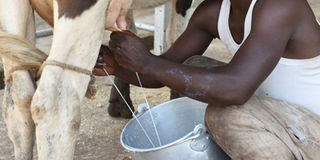Hygiene, storage key in maintaining quality milk

Milk must be kept in clean containers. Photo by Edgar R Batte
What you need to know:
- Farmers are showing increased interest in investing in a milk silos and other facilities such as stainless cans as another all-round efficient option to optimise milk storage and earn more cash from big players such as Brookside’s Fresh Dairy and Jesa Farm Dairy, writes Edgar R Batte.
To a cattle farmer, milk is white gold. For the last seven years, Patrick Nyomboine has grappled with achieving the most out of his 30 cattle.
Ticks, anthrax and lately, foot and mouth diseases have affected his cattle, and those of many farmers in Bukwiri parish, Kyankwanzi that is currently under quarantine.
Executive Director of Dairy Development Authority (DDA), Jolly Zaribwende implores farmers to vaccinate cattle against diseases to ensure good production of milk is not encumbered.
Uganda produces in the range of 1.5 litres of milk every year, according to Zaribwende.
Nyomboine produces 10 litres of milk at every milking session but he has learnt that he can produce a lot more. His curiosity is as much turned on as that of fellow farmer, Caroline Ampirirwe, a dairy farmer who produces 50 litres of milk per day.
They have been searching for answers on better practices to get the most of their cattle farming initiatives and were able to acquire knowledge at a Farmers Field Day (FFD), held in Kyankwanzi, under the auspices of Brookside Dairy Limited, a regional leader in the dairy sector and owners of Fresh Diary.
Nyomboine transports milk in jerrycans to Kasengyere Milk depot while Ampirirwe supplies hers to Mashembe Dairy Cooperative milk collecting centre. Both centres are located in Kyankwanzi town. “I have been carrying milk in jerrycans to the collecting centre but have been told that jerrycans are not the best options. Trainers recommend that we use metallic containers which can keep the milk safer and cleaner,” Nyomboine explains.
The 25-year-old was elated as winner of a motorcycle during a reward session by Brookside, after the daylong farmers’ field day. The bike he won came with the metallic cans he wanted to buy. “Roads from my home are bad and I have lost milk as I tried to manoeuvre through to get my milk to the market,” he says.
Preserving milk
A litre of milk currently fetches Shs1,000, sometimes slightly less but has attracted much more money. However the outbreak of foot and mouth disease within the corridor has affected prices.
“Quality has to be managed right from the farm. We have extended cooling facilities to different parts of the country. Like that, we are able to control the temperatures. When it gets into the glass, it is of the quality,” explained John Ngethi, director of milk procurement of Brookside, owners of Fresh Diary brand.
Sanitation
Milk is transferred from one container to another many times over the life of its processing cycle.
Each stage of processing represents risk in terms of the quality of the milk and its exposure to harmful bacteria. Consumers place a lot of trust in dairy processors to deliver a product that is wholesome and healthy. One of the key steps to achieving these goals is to design equipment that can be easily cleaned and maintained in sanitary condition.
Advantages
of milk storage
Better Protection from Corrosion
• Stainless steel is popular in the dairy industry largely due to its corrosion resistant properties.
• It contains chromium which develops a protective oxide coating on the surface of the metal.
• This layer can get damaged if not maintained properly.
• One of the ways the protective oxide layer of stainless steel can get damaged is by coming into contact with ordinary carbon steel.
• Aside from physical damage, corrosion can also cause a sanitation risk with your dairy products.
• Corroded steel can trap harmful bacteria or even mix with the product.




